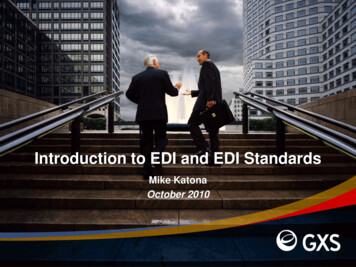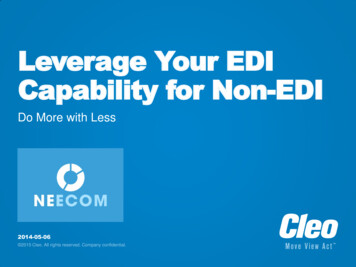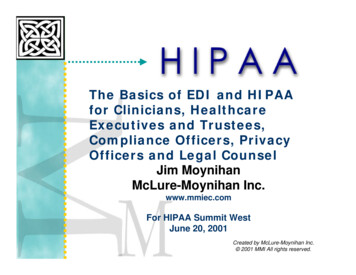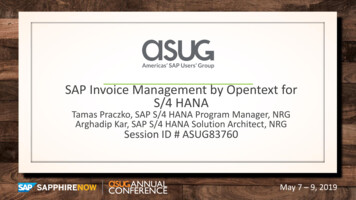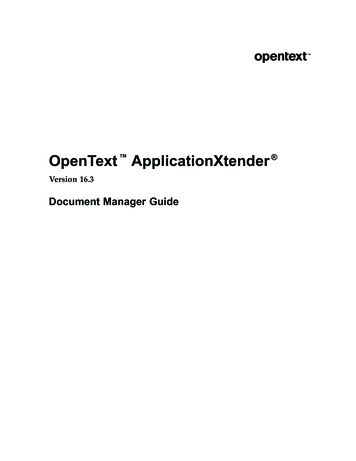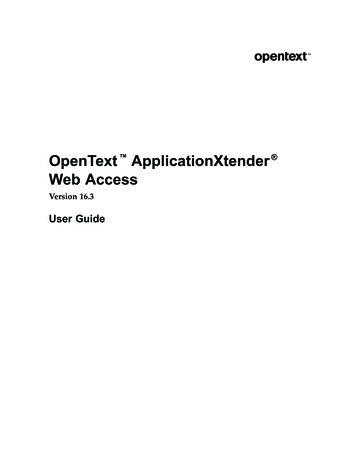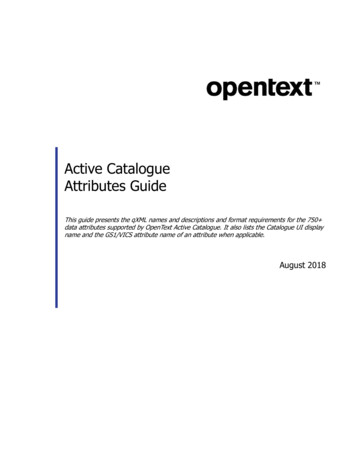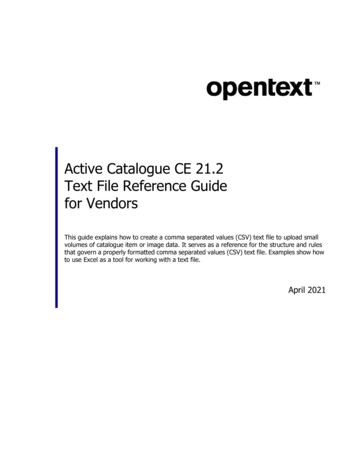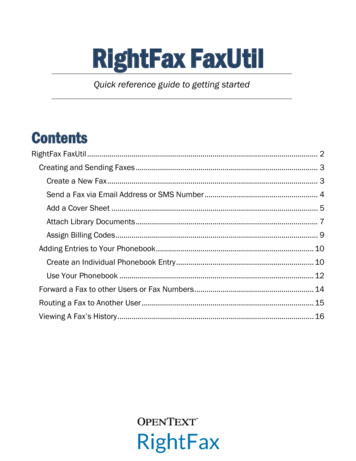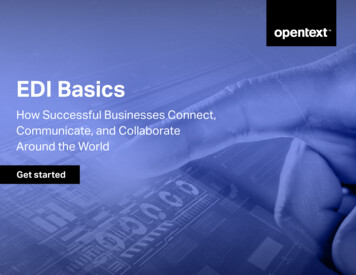
Transcription
EDI BasicsHow Successful Businesses Connect,Communicate, and CollaborateAround the WorldGet started
E-BOOKEDI BASICSTable of ContentsForeword . . . . . . . . . . . . . . . . . . . . . . . . . . . . . . . . . . . . . . . . . . . . . . . 3What is EDI? . . . . . . . . . . . . . . . . . . . . . . . . . . . . . . . . . . . . . . . . . . . . 4The EDI Process . . . . . . . . . . . . . . . . . . . . . . . . . . . . . . . . . . . . . . . . 7Sending EDI Documents . . . . . . . . . . . . . . . . . . . . . . . . . . . . . . . . 8Receiving EDI Documents . . . . . . . . . . . . . . . . . . . . . . . . . . . . . . . 9Summary . . . . . . . . . . . . . . . . . . . . . . . . . . . . . . . . . . . . . . . . . . . . . . 11The Benefits of EDI . . . . . . . . . . . . . . . . . . . . . . . . . . . . . . . . . . . . 12EDI Milestones . . . . . . . . . . . . . . . . . . . . . . . . . . . . . . . . . . . . . . . . . 14What are EDI Documents and Standards? . . . . . . . . . . . . . 15EDI Standards . . . . . . . . . . . . . . . . . . . . . . . . . . . . . . . . . . . . . . . . . 16Common Business Documents . . . . . . . . . . . . . . . . . . . . . . . . 18What Are Your Communications Options? . . . . . . . . . . . . . 20Direct Connection Model . . . . . . . . . . . . . . . . . . . . . . . . . . . . . . 21Network Model . . . . . . . . . . . . . . . . . . . . . . . . . . . . . . . . . . . . . . . . 22Direct or Network—Which is Better? . . . . . . . . . . . . . . . . . . . 23Which Business Processes TypicallyBenefit From EDI? . . . . . . . . . . . . . . . . . . . . . . . . . . . . . . . . . . . . . 26Procurement . . . . . . . . . . . . . . . . . . . . . . . . . . . . . . . . . . . . . . . . . . . 27Shipping and Receiving . . . . . . . . . . . . . . . . . . . . . . . . . . . . . . . . 28Invoicing and Payments . . . . . . . . . . . . . . . . . . . . . . . . . . . . . . . . 30What Does an EDI Document Look Like? . . . . . . . . . . . . . . . 32Segments . . . . . . . . . . . . . . . . . . . . . . . . . . . . . . . . . . . . . . . . . . . . . . 34Envelopes . . . . . . . . . . . . . . . . . . . . . . . . . . . . . . . . . . . . . . . . . . . . . 36How Does a Company Implement an EDI Program? . . . . 37Do-It-Yourself Model . . . . . . . . . . . . . . . . . . . . . . . . . . . . . . . . . . . 38B2B Managed Services Model . . . . . . . . . . . . . . . . . . . . . . . . . 41Conclusion . . . . . . . . . . . . . . . . . . . . . . . . . . . . . . . . . . . . . . . . . . . . 42Next Steps . . . . . . . . . . . . . . . . . . . . . . . . . . . . . . . . . . . . . . . . . . . . 43Connect With Us . . . . . . . . . . . . . . . . . . . . . . . . . . . . . . . . . . . . . . . 43About OpenText . . . . . . . . . . . . . . . . . . . . . . . . . . . . . . . . . . . . . . . 43Most Commonly Used Communications Protocols . . . . . 23BUSINESS NETWORK2
E-BOOKEDI BASICSForewordBill Clinton once observed, “The price of doing the same old thingis far higher than the price of change.” Companies that are slowto adapt new technology to their business processes may findthemselves consigned to the proverbial dustbin of history.Businesses have invested in technology such as Enterprise Resource Planning (ERP) systems to automateinternal business processes, including accounts payable and receivable, inventory control, and intra-companycommunication. However, many of these same companies are slow to automate their business-to-businesstransactions, such as the exchange of purchase orders, invoices, and bills of lading.Electronic commerce (e-commerce) is the exchange of information via electronic media, such as the internetand private communications networks. There are two types of e-commerce: Business-to-Business (B2B) andBusiness-to-Consumer (B2C). Almost every day, each of us experiences B2C e-commerce, such as when we bookairline tickets or hotel reservations online and then receive an electronic confirmation. This book focuses onelectronic data interchange (EDI), the most commonly used B2B ecommerce technology.In today’s business environment, EDI remains a gamechanger across all industries, including retail, banking,manufacturing, high-tech, and services. For many companies, it has become the lifeblood of their business,making them more efficient, driving down costs, and increasing customer satisfaction. It is the means by whichthey can differentiate themselves from their competition. Using EDI, a manufacturer in Detroit, Michigan can senda purchase order to its supplier in Japan, receive an electronic document indicating that the item is out of stock,and immediately react by sending the purchase order to an alternative supplier in Brazil—all in just minutes. Thishigh level of visibility that is enabled by the use of EDI is critical to business success.EDI Basics introduces you to this electronic way of doing business so that you can participate knowledgeably inthe conversation at your company about moving away from the old, manual processes.More than 85% ofall electronicbusinesstransactionstake place usingEDI. This methodof exchangingdocuments isused in industriesincluding retail,banking, high-tech,manufacturing,and services.The pages that follow answer the questions: What is EDI? How does it work? What does it take for your companyto get started?BUSINESS NETWORK3
What is EDI?In this chapter, you will learn: The definition of EDI How the EDI process works for sending and receiving documents The benefits of EDIRead more
E-BOOKEDI BASICSElectronic communication has changed the way companies conduct business with each other.Business-to-business (B2B) electronic commerce (e-commerce), which includes EDI, XML(Extensible Markup Language), and online catalogues, has enabled the integration of companiesthroughout the world into communities of business partners (often called trading partners) withbenefits for all.In today’s business environment, B2B integrationis a key to success; in fact, many companieswill no longer do business with you if you can’tdo business electronically.While many businesses have incorporated emailsand faxes into their B2B communication, theseprocesses still involve human handling and arethus slow and prone to error. Although they provideimprovements over postal mail-based processes,they lack the power and functionality of e-commerce.Figure 1 shows a simplified scenario in which a buyerfaxes or mails an order to a supplier, who then faxesor mails an invoice back to the buyer.As you can see, this manual process involves a lot ofpaper, people, and time. Mail can be slow and paperdocuments can be misplaced or lost. Once received,mailed and faxed documents must be manuallyentered into a computer application, a process thatfrequently results in errors. And even though anemail is sent electronically, it too must be enteredmanually, because the computer application has noway of knowing where each piece of data needed islocated within the email.Having people involved slows down the processingof the documents and also introduces errors.BUSINESS NETWORKSUPPLIER ENTERS ORDERINTO INTERNAL SYSTEMS ANDPRINTS AN INVOICEBUYER GENERATESPURCHASE ORDERFaxes or MailsFaxes or MailsBUYER ENTERS INVOICEINTO INTERNAL SYSTEMFOR PROCESSINGINVOICEFigure 1: Manual Document Exchange5
E-BOOKEDI BASICSIn the 1960s, the railroad industry, which needed tofind a faster and more efficient way to communicateinformation about goods being transported, began tosend this data electronically. Other businesses realizedthe value of electronically exchanging information andso, beginning in the 1980s, many industries adoptedEDI, the electronic exchange of standard-formattedbusiness documents between computers. At first, onlythose businesses that could afford large mainframecomputers were able to participate. But with the adventof the personal computer and then the availabilityof the internet, use of EDI became available to allcompanies regardless of size.Electronic Data Interchange (EDI) is the computerto-computer exchange of business documents,such as purchase orders and invoices, in a standardelectronic format between business partners,such as retailers and their suppliers, banks andtheir corporate clients, or car-makers and theirparts suppliers.The most common documents exchanged via EDI arepurchase orders, invoices, and advance ship notices.But there are many others, such as bills of lading,customs documents, inventory documents, shippingstatus documents, and payment documents.Because EDI documents are processed by computers,the computer’s program must know where to findeach piece of information in the incoming documentand the format of that data. For example, are thenumbers included in the data integer (e.g., 12)or decimal (e.g., 12.0)? Are the dates in the formmmddyy or mmddyyyy?BUSINESS NETWORKJust as two speakers of different languages cannothold a conversation, two business systems, eachwith its own proprietary format rather than a commonformat, cannot exchange data with each other.Thus, a common, standard format is the language bywhich businesses communicate with each other viatheir computers.EDI standards have been developed by organizationsof concerned businesses to identify needs, createplans to meet those needs, and come to an agreementon the proposed standards. Subcommitteescontinually meet to propose new standards or changesin response to evolving business requirements. Thereare several EDI standards in use today. The mostcommon cross-industry standards are ANSI, primarilyused in the United States, and EDIFACT, primarily usedin Europe and Asia. In addition, there are standardsfor specific industries, such as SWIFT for banking andRosettaNet for high-tech.Let’s now look at how the EDI process works.Electronic DataInterchange (EDI)is the computer-tocomputer exchangeof businessdocuments, suchas purchase ordersand invoices, in astandard electronicformat betweenbusiness partners.6
E-BOOKEDI BASICSThe EDI ProcessToday, all types of business documents for industries such as retail, automotive, high tech, logistics, and bankingcan be exchanged using EDI. These documents can flow from the sender’s computer straight through to theappropriate application on the receiver’s computer (e.g., the order management system), where processing canbegin immediately.With a fully integrated EDI system, the process can look like this—no paper, no people, and almost no time.Purchase OrderBUYER’SINTERNAL SYSTEMInvoiceSUPPLIER’SINTERNAL SYSTEMFigure 2: EDI document exchangeEDI standardsprovide a commondata format,enabling computersto communicate.There are severalEDI standards inuse today alongwith standards forspecific industries.As you can see, sending and receiving EDIdocuments can be a seamless and efficient way toconduct business.BUSINESS NETWORK7
E-BOOKEDI BASICSSendingEDI DocumentsSENDINGCOMPANYRECEIVINGCOMPANYDATA ININTERNAL FORMATDATA ININTERNAL FORMATEDI TRANSLATOREDI TRANSLATORTo send an EDI document, you need to identify thedata, create an EDI document, and transmit it.Step 1: Identify the dataThe first step is to identify the data you want to includein the purchase order, invoice, advance ship notice, etc.The sources of data and the methods available togenerate the electronic document can include:1 computer programs that extract data from systemdatabases, such as from a retailer’s purchasingsystem or a shipping company’s logistics system;2 computer programs that extract data fromspreadsheets; and3 people keying in the data via webform dataentry screens.Step 2: Create the EDI documentIn the next step, software converts your internal datainto the EDI standard format. This requires specializedtranslation software that defines how your internaldata is to be mapped (i.e. correlated) to the EDI format(see Figure 3).Translation software is available to suit just aboutany computing environment and budget, from largesystems that handle thousands of transactions dailyto PC-based software that need only process a fewhundred or fewer transactions per week.EDI NetworkService ProviderEDI DOCUMENTDirectEDI DOCUMENTFigure 3: Creating the EDI DocumentBUSINESS NETWORK8
E-BOOKEDI BASICSStep 3: Transmit the EDI documentThere are two basic ways to transmit an EDI document.The first option is to send it directly to your businesspartner, usually via the internet. The other optionis to use the services of an EDI Network ServicesProvider, in which case you send the EDI documentto the Provider, who then makes it available to yourbusiness partner.Using a Provider is often the easiest and best approachwhen you have many business partners, each usinga different communications protocol (rules) that youwould otherwise need to accommodate. See Figure 4.ReceivingEDI DocumentsSENDINGCOMPANYRECEIVINGCOMPANYDATA ININTERNAL FORMATDATA ININTERNAL FORMATEDI TRANSLATOREDI TRANSLATORReceiving an EDI document is basically the reverse ofthe sending process.1 you receive the transmitted EDI document;2 your system converts the EDI data for your internalsystem; and3 the data is fed into your internal system forprocessing, such as into a bank’s payment originationsystem or a supplier’s order management system.EDI NetworkService ProviderEDI DOCUMENTDirectEDI DOCUMENTFigure 4: EDI Transmission OptionsBUSINESS NETWORK9
E-BOOKEDI BASICSStep 1: Receive the transmittedEDI documentAs with sending a document, there are two basicoptions. You can receive the EDI document directlyfrom your business partner or you can use the servicesof an EDI Network Services Provider, in which case yourProvider receives the EDI document from the senderand then makes it available to your internal system.Step 2: Convert the EDI document foryour internal systemSoftware now converts the data from the incomingEDI document into the format used by your internalsystem. This requires specialized translation softwarethat defines how the EDI data is to be mapped (i.e.correlated) to your internal data format.SENDINGCOMPANYRECEIVINGCOMPANYDATA ININTERNAL FORMATDATA ININTERNAL FORMATEDI TRANSLATOREDI TRANSLATORThe same specialized translation software that is usedto create EDI documents for sending is used in thereceiving process (see Figure 5).Step 3: Feed data into your internalsystem for processingYour computer application can now automatically feedthe translated data into your system, such as yourorder management system, for immediate processing.Or, often for smaller companies that haven’t fullyintegrated EDI with their internal systems, the incomingdata is made available either as a report or on thecomputer screen.EDI NetworkService ProviderEDI DOCUMENTDirectEDI DOCUMENTFigure 5: Converting the EDI DocumentBUSINESS NETWORK10
E-BOOKEDI BASICSSummaryThus, there are several options available to you whenconfiguring an EDI system for your business. You canperform data conversion in-house or use the servicesof an EDI Network Services Provider. You can transmityour documents directly to your business partners viathe internet or transmit via an EDI Network ServicesProvider. Or, you may use a combination of theseoptions in order to satisfy the requirements of yourvarious trading partners.Figure 6 provides an overview of an EDI process inwhich the sender and the receiver each manages itsown data conversion processes.With a fully integratedEDI system, the processinvolves no paper, nopeople, and almost no time.SENDINGCOMPANYRECEIVINGCOMPANYDATA ININTERNAL FORMATDATA ININTERNAL FORMATEDI TRANSLATOREDI TRANSLATOREDI NetworkService ProviderEDI DOCUMENTDirectEDI DOCUMENTFigure 6: EDI Process OverviewBUSINESS NETWORK11
E-BOOKEDI BASICSThe Benefits of EDIEDI has helped simplify and improve commercebetween trading partners for more than 30 years andits benefits continue to expand as it improves businessprocesses such as electronic procurement, automatedreceiving, electronic invoicing, and electronicpayments. EDI can help your company reduce thecost of personnel and office space, improve dataquality, speed up business cycles, improve efficiency,and provide strategic business benefits.Let’s look atthe benefits that businesses across all industries arerealizing by using EDI.Reduced costsEDI reduces the costs of personnel, supplies, andoffice and storage space. Since paper documents arereplaced by EDI transactions, expenses associatedwith paper—printing, reproduction, storage, filing,postage, and document retrieval— are all reduced oreliminated. Moving from a manual to an EDI processfrees up personnel to concentrate on other aspects ofthe business.Improved data qualityWhen bad data makes its way into your internalsystems, such as your accounts payable ortransportation management systems, the results havea negative impact on your business. This includesoverpayments, late or underpayments resulting inadditional fees, lost revenue due to delays, and poorcustomer service.The root of most data errors is the keying in of datafrom a paper document into your internal system.First, if the paper document is handwritten rather thancomputer-generated, it may be difficult to read, leadingto input errors or phone tag to obtain clarification,BUSINESS NETWORKboth of which can cause delays in the business cycle.Even when the document is typed or computergenerated and thus legible, keying errors can stilloccur. In the order entry process, these errors canresult in shipping the wrong product, in the wrongquantity, at the wrong price, to the wrong address.The electronic capture of business documents enablescritical business data to be fed directly into yourinternal systems without relying on errorprone, manualre-keying, which is required when you use paper-basedor email-based processes. Having more accurate datameans that the entire supply chain is more efficient.Shorter business cycleWe have just discussed how manual data entry cangreatly slow the business cycle. In addition, when usingpostal mail, your documents will take days to arrive.Sometimes, it may be weeks before you discover thatthe mail has been lost. Delivery services such as UPSand FedEx are very reliable but quite costly. And evenwith faxes, documents can remain at the fax machineor sit on someone’s desk before any action is taken.In contrast, EDI transactions can be exchanged inminutes instead of the days or weeks associatedwith postal mail. Furthermore, there is significanttime saved by the elimination of data re-keying andits high error rate, which results in time-consumingcorrective actions.Improved business efficiencyThe benefits of streamlining processes with EDI canhave a ripple effect throughout many of the operationsof a business. Automating paper-based tasks freesstaff to concentrate on higher-value tasks andprovides them with the tools to be more productive.For example, the use of EDI leads to less reworking oforders and invoices resulting from the elimination oferrors due to manual data entry, invalid data, or missingdata. EDI ordering and shipping provide greatervisibility into the supply chain, leading to fewer stockouts and resulting lost sales. EDI invoicing enablesbuyers to process and approve i
Electronic Data Interchange (EDI) is the computer-to-computer exchange of business documents, such as purchase orders and invoices, in a standard electronic format between business partn
